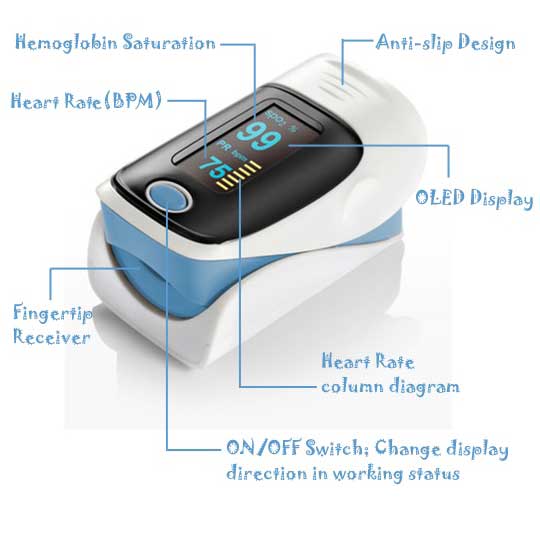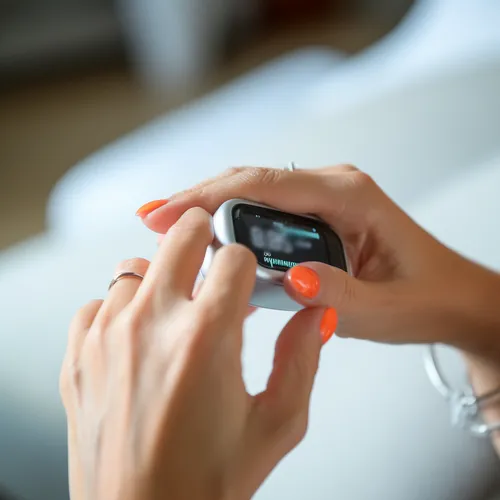Everything You Need To Know About Pulse Oximeters
How does a pulse oximeter work?
A pulse oximeter is the small device that clips onto your fingertip to measure your blood oxygen level and heart rate. It works by shining light through your finger to determine how much oxygen is in your blood.
Oxygenated blood with oxygen attached to hemoglobin absorbs different wavelengths of light compared to blood without oxygen attached. The pulse oximeter sensor detects this difference in light absorption to calculate your oxygen saturation percentage, known as SpO2. Normal values are between 95-100%.
Do I need a pulse oximeter?
For most healthy individuals, regular pulse oximeter readings aren’t necessary. However, they can be very useful for monitoring lung or heart conditions. Many people with asthma, COPD or other respiratory diseases use a pulse oximeter at home to track their oxygen levels day-to-day.
During the COVID-19 pandemic, pulse oximeters have also become helpful for early detection of low oxygen levels that can occur with coronavirus infection, even before symptoms like shortness of breath arise. This condition is known as silent hypoxia.
Monitoring with a pulse oximeter allows early medical intervention which can prevent complications and improve outcomes. People at higher risk from COVID-19, including those over 60 or with underlying conditions, may benefit most from having a home pulse oximeter.
How to use a pulse oximeter
- Turn on the pulse oximeter and wait for it to display readings.
- Place the sensor on your fingertip, avoiding the thumb. Have the cable run along the back of your hand.
- Remain still and quiet while it reads your blood oxygen and heart rate. This takes at least 10 seconds.
- Note the SpO2 percentage (oxygen saturation) and heart rate on the display. Some devices beep along with your pulse.
- Keep the sensor on to monitor regularly, such as every 2-3 hours. Change fingers periodically to avoid discomfort.

Interpreting pulse oximeter readings
For most people, normal blood oxygen levels range from 95-99%. Levels below this may indicate respiratory issues and warrant medical assessment. In particular, levels below 90% are considered dangerously low and require immediate treatment.
However, for people with chronic lung disease, baseline oxygen levels may normally be below 95%. In this case, watch for drops from your usual stable readings instead.
Remember that pulse oximeters aren’t a substitute for medical advice. Always seek guidance from your healthcare provider if you have concerns about your oxygen levels or health.
What to look for when purchasing a pulse oximeter
When selecting a pulse oximeter for home use, here are some key factors to consider:
Accuracy – Look for a pulse oximeter that is clinically validated to have accuracy of ±2% in the 70-100% SpO2 range. Avoid cheaper models which can be less reliable.
Sensor type – Finger clip sensors that wrap around the tip of your finger tend to be more accurate than other types like wrist or palm sensors. However, some people may prefer a wrist sensor for continuous monitoring.
Display – Choose a pulse oximeter with a high contrast OLED or LED display that is easy to read in different lighting conditions. Large, bright numbers are best.
Alarms – Audible and visual alarms that alert you when oxygen saturation drops below a set level can provide an early warning of issues. This is a useful safety feature.
Rechargeable battery – For regular daily use, a rechargeable battery avoids having to replace disposable batteries frequently. Check the battery life when fully charged.
Additional features – Some pulse oximeters also measure perfusion index, pulse waveform and breath rate. While not essential, these can provide more comprehensive monitoring.
Easy to use – Ensure the device and finger sensor are comfortable and simple to operate even for those with dexterity or vision issues. An intuitive interface is ideal.
Portable size – For finger pulse oximeters, a compact, lightweight size allows for easy mobility around the home and for travel. Durability is also a plus.
While finger pulse oximeters vary widely in features and accuracy, following these criteria helps narrow the options to high quality home monitoring devices for improved respiratory health. Consult your doctor for personalized advice on selecting and using a pulse oximeter.
Click here to view the full range of finger pulse oximeters from Zoom Health
Side effects and safety
Pulse oximeters are generally safe medical devices when used as instructed. However, be aware of some potential side effects and safety issues:
Skin irritation – The finger sensors emit low-intensity light that typically doesn’t cause problems. But for some people, it can lead to skin irritation, redness or blistering with prolonged use, especially those with circulation issues or sensitive skin. Periodically change fingers if using for long periods.
Inaccurate readings – As discussed earlier, certain factors like poor circulation, skin pigmentation and nail polish can affect accuracy. Use the trends rather than absolute numbers to guide you.
Medical alarms – Pulse oximeters can set off alarms for conditions like arrhythmias which are harmless for some patients with underlying medical issues. Always validate readings clinically before making treatment decisions.
Infection control – Clean and disinfect the device, following manufacturers guidelines, before sharing it with others. This prevents potential spread of infectious diseases.
Psychological effects – Seeing abnormal readings can provoke anxiety in some users. Balance this with the benefits of monitoring and by discussing concerns with your doctor.
While limitations exist, pulse oximeters remain valuable for tracking oxygen levels when used with care. Let your doctor know if you experience any problems using one.
This section provides helpful context around safe, effective use of pulse oximeters for home monitoring by covering potential side effects, accuracy limitations and safety considerations. It could be inserted after the “Interpreting Pulse Oximeter Readings” section.
What does my blood oxygen level reading mean?
- 95-100%: Normal oxygen saturation
- 90-94%: Low oxygen levels, may need medical assessment
- Below 90%: Dangerously low oxygen, requires immediate medical treatment
For people with chronic lung conditions like COPD, normal readings may be below 95%. In this case, watch for drops from your usual baseline instead of just low numbers.
If you have symptoms like shortness of breath, wheezing or bluish lips/fingernails along with low oxygen saturations, seek medical help right away.
Remember that context matters – consider your health status, altitude, activity level and other symptoms along with pulse oximeter readings. They provide helpful information, but don’t replace medical advice. Speak to your doctor if you have concerns about your oxygen levels.
This section could be inserted right after the “Interpreting Pulse Oximeter Readings” section to provide more details on understanding the meaning of SpO2 levels. The rewritten version helps clarify the context of the readings for the reader.
Are pulse oximeters accurate?
While pulse oximeters provide close estimates of blood oxygen saturation, certain factors can affect accuracy:
- Nail polish or artificial nails may lower readings.
- Poor circulation from cold hands can provide falsely low readings.
- Skin pigmentation may cause pulse oximeters to underestimate true oxygen levels. This occurs particularly at lower saturations.
Despite these limitations, pulse oximeters remain useful indicators when used properly. Consult medical professionals for any concerning readings or respiratory symptoms.
Using a pulse oximeter along with awareness of your individual health status provides valuable insight into your wellbeing, especially respiratory function. This small device empowers you to monitor your health from home and make informed decisions about seeking healthcare.
Photo “Orange Nails & Finger Pulse Oximeter” by Anthony Cunningham for Zoom Health
Zoom Health is a leading UK supplier of Home Health Tests and Earplugs





